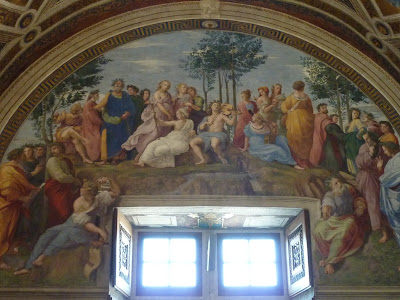The older papal apartments are now called the Rafael Rooms, several of them, noted for some of the most famous paintings of western art. Every square inch of the large halls is covered in Renaissance art and ornamentation, mostly by Rafael and his students, and I'll just post a few favorites.
 |
The Constantine Room is covered in giant murals about the
Emperor Constantine, who legalized Christianity (Justinian
criminalized all other religions a century later); the ceiling, by
Tommaso Laureti is titled "The Triumph of Christianity Over
Paganism" and has always epitomized for me the Church's
historic intolerance and contempt for the older civilizations
...onto which it grafted itself as soon a possible
|
 |
Rafael's "Expulsion of Heliodorus" (Protestants: you'll have
to find and read the Book of Maccabees to appreciate this)
|
 |
Pope Leo the Great meets Attila the Hun at the gates of
Rome; after a brief (armed) fly-by of SS Peter and Paul,
Attila decides to maybe sack some other place; actually, the
meeting occurred near Mantua; interestingly, the worst sack
of Rome occurred in 1527, under ther auspices of the Holy
Roman Emperor, His Most Catholic Excellency King
Charles V of Spain; always stranger than fiction...
|
 |
Right after the triumph of Christianity over paganism
and Seleucids and Huns, one enters a room glorifying the
ancients; here, one of Rafael's greatest hits, "The School of
Athens," with Plato, Aristotle, Socrates, Diogenes,
Pythagoras, Archimedes, et aliud; a time when the Church
was trying to appropriate what it could of the ancient world
|
 |
Closer up: the guy in the foreground left, lavender tunic, was
added later--Rafael's flattering portrait of his contemporary
Michaelangelo
|
 |
And Rafael himself, right corner, black hat
|
 |
Not least of Rafael's problems in doing these rooms was the
challenge of working around doors, windows, HVAC, et
cetera; here is the great painting of the arts, literature, and
music, Apollo and the 7 (9? 12? 40?) muses, blind Homer in
blue on the left, and an interesting prominence for Sappho,
lower left
|
 |
And then there's the ceiling with all the roundel things (a
causal theory of knowledge espoused here?)
|








No comments:
Post a Comment